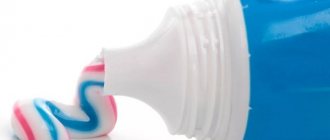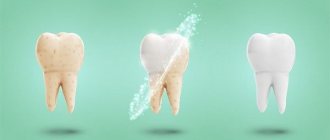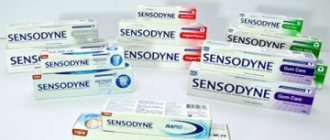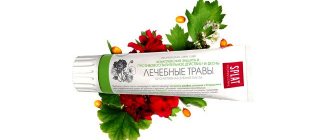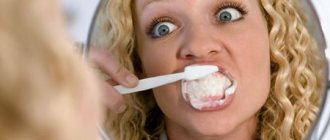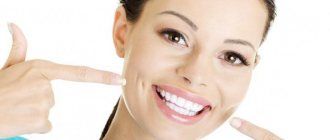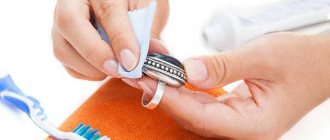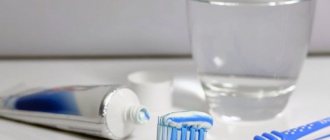The history of toothpaste dates back at least 5,000 years ago, and is associated with the culture of Ancient Egypt. Dental problems of those times were no different from modern ones - caries, unhealthy plaque, bad breath and various gum diseases. The lack of a toothbrush and paste was not a reason for a person not to take care of his oral hygiene. And, if before the invention of a special brush, clean people most often used their fingers, then our ancestors didn’t put anything in their mouths as a cleaning agent!
How did ancient people brush their teeth?
One of the first mentioned compositions, the exact recipe of which, unfortunately, has not reached our time, included such ingredients as ashes from burnt ox liver, crushed egg shells and pumice with the addition of myrrh and urea. Its authorship is attributed to the ancient Egyptians. The ancient Chinese used even more complex compositions to brush their teeth, but, unfortunately, the composition of the mixture was so sophisticated that the only component familiar to us was salt. Subsequently, various mint herbs and ginseng root appeared in the recipe.
It is known that to prevent problems with gums and teeth in Ancient Rome, it was recommended to rinse your mouth with fresh turtle blood once every few months, and they also tried to relieve toothache with it. And to eliminate the unpleasant odor, they used tree bark, goat's milk and crushed charcoal.
Mentions of other ingredients have also come down to us - crushed corals and sea shells, gypsum, sand, coal, talc, as well as ashes from the burning of the heads of mice and killed wolves, hooves, horns and joints of cattle. To give it all a pleasant smell, rose petals, mint and other pleasant-smelling substances that were not always useless for health were used.
The oldest powder found (not described) was discovered in Egypt. It is a little less than 2000 years old. It was possible to identify salt, pepper and mint in its composition.
Prevention of caries
Caries is the most common disease in the world. This is a pathological process of destruction of hard tooth tissues. It begins with a white spot and ends with pulpitis and various septic processes with inevitable tooth loss.
The main cause of caries is bacteria that produce acids. They wash fluoride and calcium out of the tooth tissue and weaken it. Frequent consumption of sweets accelerates the development of carious bacteria: carbohydrates are a favorite environment for their reproduction. Teeth with thinned enamel are also at risk: through microcracks, bacteria penetrate into the dentinal tubules and begin to destroy the tooth from the inside.
The most important stage in effectively combating caries is early diagnosis of the problem and, of course, prevention. Remove plaque at least once every 12 hours, and visit the dentist every 6 months!
In addition to caries, the TOP 5 most common dental problems are:
- Raid.
- Unpleasant smell.
- Sensitive enamel.
- Bleeding gums.
- Color change.
Middle Ages
Then, in the history of toothpaste development, there was a long stagnation. There were no breakthroughs in these troubled and sad times in this direction. The Inquisition was rampant, ignorance flourished, and all kinds of superstitions were very strong. Recipes for oral care products from those centuries sounded strange, to say the least, and sometimes looked like a sentence. For example, the composition of the most popular tooth powder at that time included ground crackers, which were chewed on by a mouse. In Europe, the situation was even worse than the “global average.” Complete unsanitary conditions reigned here, slops poured out right next to the house, washing clothes was extremely rare, and baths were taken only on major holidays, and even then not always. Probably many Europeans of the Middle Ages did not brush their teeth even once in their lives. The only items in use were toothpicks, and special “cleanies” used mouth rinsing after a meal.
News
Mention of dental care and appropriate products is already found in written sources of Ancient Egypt. According to the testimony of ancient chroniclers, about five thousand years ago, the Egyptians achieved pearly white teeth using powder from dry incense, myrrh, kau, branches of the mastic tree, ram's horn and raisins. In the Ebers papyrus, for oral hygiene, only rubbing teeth with onions is recommended, which made them white and shiny; one of the found manuscripts describes a recipe for a certain remedy, which included the following ingredients: ashes of the entrails of an ox, myrrh, ground eggshells and pumice, to Unfortunately, the method of using this remedy remains a mystery. It was on the territory of Egypt that the first “civilized” toothbrushes appeared; the Egyptian ancestor of toothbrushes was a stick with a fan at one end and a pointed tip at the other.
Maintaining oral hygiene was important not only in Ancient Egypt; in India and the Chinese Empire, crushed shells, horns and hooves of animals, gypsum, as well as powdered minerals were used as cleansing compositions; wooden sticks were used, split at the ends in the form of a brush, metal toothpicks and tongue scrapers.
The credit for further improvement of toothpaste itself belongs to two great civilizations in human history - the ancient Greeks and Romans; it was the Mediterranean states that became the cradle of medicine. The first toothpaste recipes date back to 1500 BC. The famous healer Hippocrates (460-377 BC) made the first description of dental diseases and recommended the use of toothpastes. In the second millennium BC. e. already used tooth powder made from pumice with the addition of natural acids - wine vinegar or tartaric acid.
The ancient Aesculapians were the first to learn how to tie loose teeth together and hold artificial ones in place using gold wire. The first lead instrument for removing teeth was invented in ancient Rome. Particular attention was paid to such aspects as fresh breath, to maintain which it was recommended to consume goat's milk. But the effectiveness of some of the recommendations for dental care, such as rubbing the ashes of burnt animal parts (mice, rabbits, wolves, bulls and goats) into the gums, rinsing teeth with turtle blood three times a year, wearing a wolf bone necklace as a dental talisman pain would raise great doubts today.
The history of the development of oral care products after the fall of the Roman Empire remains a mystery until 1000 AD, when oral care instructions found during excavations in Persia date back to this period. These guidelines warned against the use of too harsh tooth powders and recommended the use of antler powder, crushed snail and clam shells, and calcined plaster. Other Persian recipes included compositions of various dried animal parts, herbs, honey, minerals, aromatic oil, etc.
The era of Arabic medicine extended to the period 8-12 centuries. In accordance with the Koran, the Arabs brushed their teeth several times a day according to the established ritual with the help of miswak - a stick of fragrant wood with a split end like a brush and a chital toothpick - from the stem of an umbrella plant, and also from time to time rubbed their teeth and gums with rose oil, myrrh, alum, honey.
In the Middle Ages, dental elixirs came into fashion; they were made by doctors and monks, and the recipe was kept secret. The greatest success fell to the tooth elixir of the Benedictine fathers. It was invented in 1373, but at the beginning of the twentieth century it was still sold in pharmacies.
The famous 16th century surgeon Ambroise Paré recommended careful oral hygiene: remove all food debris from the teeth immediately after eating; it is necessary to remove tartar, as it acts on teeth like rust on iron; After removing stones from the teeth, the mouth should be rinsed with alcohol or a weak solution of nitric acid. To whiten teeth, weak solutions of nitric acid were most often used. Tooth powder, and then toothpaste, which are closest to modern ones, first appeared at the end of the 18th century in Great Britain. Although the powders were formulated by doctors and chemists, they often contained overly abrasive substances that could harm teeth: brick dust, crushed porcelain and clay shards, as well as soap. The dentifrice was sold in a ceramic container in two forms as a powder and a paste. People of good income had the opportunity to use a special brush to apply it, and those who were poorer did it with their fingers. The novelty did not arouse much enthusiasm, and soon in one of the magazines there appeared recommendations from experts not to use these powders, but to brush your teeth once every two weeks with a stick immersed in gunpowder.
In the 19th century, most dentifrices remained in powder form, sold in special small paper bags. Now its goal was not only to remove plaque, but also to at the same time give freshness to the breath, for which various natural additives were mainly used, such as strawberry extract. To make these products more palatable, glycerin was added to tooth powders.
In the 50s dentist John Harris suggested using chalk to make tooth powders, to which plant extracts or essential oils were added. In the second half of the 19th century, work began on the creation of toothpastes. The finest chalk powder was evenly distributed in the jelly-like mass. First, starch was used as a binder, from which a special paste was prepared in an aqueous solution of glycerin. Later, starch was replaced with a sodium salt of an organic acid, which stabilizes the chalk suspension.
In 1873, Colgate introduced a flavored “liquefied” powder-paste in a glass jar to the American market, but consumers did not immediately accept the new product due to the inconvenience of packaging. In 1892, dentist Washington Sheffield invented the toothpaste tube. In 1984, a pump-feed tube was developed much like the ones we use today. In 1896, Mr. Colgate began producing toothpastes in tubes using his own technology, thanks to which both the tube and this paste received universal recognition in America and Europe, as they had not only higher hygiene and safety, but also undeniable household advantages: compactness and portability. With the introduction of packaging in a tube, toothpaste has become a basic necessity for people.
Before World War II, most toothpastes contained soap, although it was known to have many side effects. With the development of chemical technology, soap was gradually replaced by modern ingredients such as sodium lauryl sulfate and sodium ricinoleate.
Not only toothpastes, but also rinses became increasingly popular. They often contained chlorophyll to give a fresh green color. In 1915, extracts from certain trees growing in Southeast Asia, such as eucalyptus, began to be introduced into the composition of the products. “Natural” toothpastes containing mint, strawberry and other plant extracts are also used.
The development of technology has made it possible to significantly expand the spectrum of action of toothpaste. In addition to their main purpose - to clean teeth from plaque and freshen breath - they acquire therapeutic and preventive properties due to the inclusion of special additives. The first extended-release toothpaste appeared at the beginning of the 20th century. It contained a therapeutic and prophylactic additive - the enzyme pepsin, which, according to manufacturers, helped whiten teeth and dissolve plaque. The most important discovery of the 20th century in the field of oral hygiene can be considered the introduction of fluoride compounds into toothpastes, which help strengthen enamel. In 1956, Proctor & Gamble introduced the first anti-caries fluoridated toothpaste, Crest with Fluoristat.
But the improvement of paste recipes did not stop there. In the 70-80s, fluoridated toothpastes began to be enriched with soluble calcium salts, which strengthen dental tissue. And in 1987, the antibacterial component triclosan began to be included in toothpastes.
The USSR lingered in the era of tooth powder for almost three-quarters of a century; the first Soviet toothpaste in a tube was released only in 1950. Before this, pastes were sold in tin, and later in plastic jars. True, even in this package, toothpaste appeared on store shelves quite rarely; the undisputed leader in sales was tooth powder, which became so firmly established in the life of Soviet people that it penetrated into areas unusual for its intended purpose. In home economics books of the time, you will find tips on using tooth powder to clean windows, clean canvas shoes, or shine metal utensils. The powder went away following the fashion for canvas. Consumers enthusiastically accepted the new product - a foamy and fragrant toothpaste.
Nowadays, the production of toothpaste is a complex production process, behind which there is numerous research by scientists and the practical knowledge of dentists. The spectrum of their action today is so wide that toothpaste can be used not only as a hygiene product, but also as an important element of drug treatment. Now there are many pastes for various purposes.
According to market research firm Nielsen, toothpastes currently account for 62% of the global dental care market. The most popular of these are anti-caries toothpastes, followed by toothpastes that offer comprehensive tooth protection, as well as whitening toothpastes.
If the trends of the 20th century continue in the 21st century, we will use toothpastes that play an active role in the prevention of diseases of the teeth and gums, have a whitening or other additional effect, do not cause irritation to the mucous membranes and turn brushing teeth into a real pleasure. It is important to remember that each person has his own physiological characteristics, and accordingly, you need to buy not just any toothpaste, but the one that is more suitable for your teeth than others.
Oral hygiene products in the 8th-19th centuries
The good work of developing and improving toothpaste began only at the end of the 8th century, although its beginning was not entirely successful. The products of that time could hardly bring anything other than direct harm to the teeth, although in appearance and consistency they already had some similarities with modern analogues.
For their production, ingredients such as broken brick, crushed porcelain and clay were used, and soap was added to bind it all into a kind of paste. It is quite expected that such funds did not find a large number of admirers.
The first good quality toothpaste appeared only in the middle of the 19th century. The basis for it was starch and glycerin, which contained chalk paste in a jelly-like state. And yet, powder remained the main hygiene product for teeth. They packed it in paper bags, which was extremely inconvenient during water procedures.
First pasta
The year 1873 can be considered a turning point in the history of toothpaste. A certain pharmacist from New York named Colgate decided to eliminate the paper version of packaging and sell tooth powder liquefied in glass jars. In fact, the idea turned out to be so-so, since scooping this jelly-like mass from a jar onto a brush was even more inconvenient, unhygienic and impractical than pouring powder from a bag. However, thanks to the entrepreneurial spirit of this pharmacist, his name is very familiar to modern people. About how he managed this - a little further.
Selection criteria - what to look for
To choose the ideal product for yourself, it is important to take into account many factors at once: the condition of the enamel, the presence of carious processes and tartar, the condition of the gums, age and much more. When you have a clear idea of the current state of the oral cavity, you can move on to specific selection criteria.
Type of pasta
As mentioned above, you need to choose a product based on individual needs and indications. If there are no problems with your teeth and gums, a prophylactic paste would be the best option. If there are problems with the enamel or the condition of the mucous membrane, it is worth considering treatment and preventive options. But in this case, you must first consult a dentist.
You need to choose a product based on individual needs and indications.
Ingredients
Be sure to read the ingredients carefully before purchasing. If there are allergy sufferers in the family, it is important to make sure that there are no components that can provoke allergic reactions. It is advisable to choose products with a minimum concentration of preservatives and foaming agents. Fluoride is often added for an anti-caries effect, but this same component can have the opposite effect if teeth are in contact with it for a long time. It is recommended to use according to indications.
On a note! On the question of how to choose a product based on the stripes on the tube: forget that these designations have anything to do with the composition. In fact, these are just marks for packaging machines that are needed only at the production stage. The color is related to the characteristics of the equipment used and does not indicate anything about the safety of the product.
Baking soda removes plaque well and helps soften hardened deposits. But due to its high degree of abrasiveness, it can easily damage the enamel and lead to its thinning. Therefore, it is advisable to use such products in courses and according to indications. Some compositions are as close as possible to natural ones, but these usually cope worse with their main task, do not foam well and are more expensive. Keep in mind that the concentration of parabens (preservatives) should not exceed 2%, and the surfactant content should be within 1-3%.
Degree of abrasiveness
The presence of abrasive particles ensures high-quality mechanical cleaning of plaque and allows you to return your teeth to their natural whiteness. On the other hand, too long exposure of this kind leads to injury to the enamel, its thinning and hyperesthesia. The abrasiveness indicator is indicated by the RDA marking. If it is a whitening paste, then this indicator can reach 100 units. Conventional preventive – up to 80 maximum, gentle (dental) – no more than 601.
Taste and smell
As for taste and smell, these criteria are left to the discretion of the user. Sometimes a too strong taste can cause unpleasant sensations or even gag reflexes - this also needs to be taken into account.
Taste and color are also criteria for choosing a product
First tube
Surprisingly, the dental tube knows exactly its birthday - May 22. It was on this day in 1892 that it was invented by the American dentist Washington Sheffield. More precisely, he did not come up with the tube itself, but the idea of using it.
While thinking about how to conveniently package a hygienic product, the doctor remembered or learned for the first time about a certain artist who, half a century ago, stored his paints in tin tubes to protect them from drying out. After thinking a little about modernizing the packaging, the dentist made an almost modern tube for dental cream, i.e. became the one who invented both toothpaste and modern packaging for it. But who created a thriving industry on it is another question.
Teeth cleaning.
DISCOVERY OF LEVENHOEK.
Brushing teeth with salt is Leeuwenhoek's invention: Anthony van Leeuwenhoek is a Dutch naturalist, microscope designer, founder of scientific microscopy, member of the Royal Society of London. In 1674, the Dutch inventor Anthony van Leeuwenhoek made two outstanding discoveries simultaneously. He discovered the world of microbes and a way to destroy this very world in his own mouth with the help of salt. One day, under the lens of the microscope he invented, there was a wash from his own teeth, teeming with small creatures. Having wiped his teeth with a cloth with salt, he did not find any microbes on the new wash. After that, he vowed to himself to practice brushing his teeth with salt for the rest of his life. And Levenguk lived for 93 years.
Missed opportunity
A New York dentist managed to invent both toothpaste and a tube for it, but didn’t think of patenting it! And, as you know, if the inventor forgets to do this, others do it for him. This is where the cunning pharmacist Colgate appears on the scene again, who understands how promising the idea is and runs to the patent office, where he patents the invention as his own. Having changed only tin to aluminum, his company begins to package many of its products in tubes - creams, soaps, shampoos, etc. But in fact, we are still using the idea of a dentist who is not very enterprising.
When did toothpaste appear in Russia?
Progress came to Russia much later. From time immemorial, birch charcoal was used to clean teeth in Rus', and mint was used to freshen breath. For the winter it was specially dried for this purpose. By the way, they acted very far-sightedly, because, in addition to a pleasant aroma, mint also has antibacterial properties. In more northern regions and in Siberia, mint was replaced by needles of coniferous trees - cedar, larch, fir. In some areas, cedar or pine resin was preferred. In addition, in Rus', people have always chewed zabrus (a wax cap containing honey cut from a honeycomb).
Everything changed, like many things in our country, with the coming to power of Peter I, who gave an order to brush your teeth with chalk, in the European way. It was applied to the enamel and then rubbed with a piece of cloth. And this continued for more than a century.
They gradually began to add soap and tree resin to the chalk powder, and then borax. At the turn of the 20th century, taste-improving glycerin appeared on the ingredient list. There was no single recipe, each pharmacist was “his own director” and charged a lot for the author’s work, so only wealthy people could afford this product, and brushes specially designed for cleaning.
The paste appeared in Russia 30 years later than its invention, and the Soviet product, packaged in a tube, was half a century late, seeing the light only in 1950 (and almost immediately fell into the category of scarce goods), and even then thanks to the space industry. Active developments were underway in this direction, and brushing teeth in a state of weightlessness with powder was inconvenient not only physically, but also in front of the entire world community. The first paste was called “Pearl” and it was produced specifically for future cosmonauts, as were special tubes of food.
Compound
Previously, calcium carbonate was used as an abrasive in pastes, but it was gradually abandoned because it is not chemically inert and reacts with other components of the paste. In addition, the crystalline structure of calcium carbonate is close to needle-shaped, which means it is traumatic for tooth enamel. Now it has been replaced by weak abrasive reagents - silicon compounds (aerosil, aluminosilicate, silicon dioxide, silicon hydroxide, dicalcium phosphate).
Surfactants (surfactants) are responsible for foaming the paste. The most common are sodium lauryl sulfate and betaines. The introduction of a surfactant allows you to reduce microdamage to tooth enamel when brushing your teeth to a minimum. In addition, according to numerous sociological studies, most people are adherents of highly foaming toothpastes.
To form a homogeneous consistency, binders are used - agar preparations, pectin, dextran, glycerin, sodium alginate, sodium carboxymethylcellulose.
The active components of toothpastes are substances that have a therapeutic and prophylactic effect - aluminum lactate, fluorides, compounds with antimicrobial activity, individual micro-, macroelements and polymineral complexes, extracts of medicinal herbs, enzymes, propolis, etc.
The anti-carious effect is ensured by the presence of fluorides (sodium fluoride, tin fluoride, amino fluoride, monofluorophosphate) and calcium (calcium glycerophosphate) in toothpaste. The anti-inflammatory effect is usually achieved by adding herbal extracts (mint, shavliya, chamomile, etc.) to toothpaste. Whitening pastes contain sodium bicarbonate, or soda, which has a pronounced abrasive effect. It is not recommended to use such pastes every day due to the risk of damage to the enamel. It is usually recommended to use them 1-2 times a week.
Recently, pastes based on sorbents (polydimethylsiloxane, methylsilicic acid hydrogel) have been actively developed. The use of enterosgel in toothpastes allows one to obtain not only a mild abrasive effect, but also a pronounced sorption effect towards microorganisms and an enamel-protective effect. In addition, pastes of sorption action have the ability to absorb odors formed as a result of the vital activity of microorganisms (halitosis). K: Wikipedia: Articles without sources (type: not specified)[ source not specified 2311 days
]
Both natural and identical to natural compounds act as flavoring agents. Of the natural ones, the most commonly used aromatic components of essential oils (terpenoids) are menthol, thymol, corvacrol, limonene, squalene, etc. The use of synthetic fragrances allows us to reduce the cost of the final product.
In clinical practice in developed countries, synthetic hydroxyapatite is used as a bone tissue substitute. Reducing the sensitivity of teeth, protecting the surface areas of the enamel, hydroxyapatite has anti-inflammatory properties, adsorbing microbial bodies, and forestalls the development of purulent-inflammatory processes. In addition, hydroxyapatite stimulates the growth of bone tissue (osteogenesis), provides microprocessing of bone and dental tissues with calcium and phosphorus ions, “bricking” microcracks in them. It has high biocompatibility and is devoid of immunogenic and allergic activity. Synthetic hydroxyapatite has very small particle sizes (0.05 microns). Such parameters significantly increase its biological activity, since the sizes of its molecules are comparable to the sizes of protein macromolecules.
An effective additive is triclosan, which acts against a wide range of bacteria, fungi, yeast and viruses. The antimicrobial activity of triclosan is based on the disruption in its presence of the activity of the cytoplasmic membrane and the leakage of cellular components of low molecular weight.
Toothpastes also contain urea with components such as xylitol and sodium bicarbonate, which are therapeutic and prophylactic additives. This mixture neutralizes the effects of acids, mainly lactic acid, which is produced by plaque bacteria by fermenting carbohydrates found in foods and drinks. Bacteria produce, although in much smaller quantities, other acids, such as acetic, propionic and butyric. The formation of acids leads to a decrease in the pH of dental plaque: at a pH less than 5.5, the process of demineralization of tooth enamel begins. The longer the duration of such demineralization, the higher the risk of caries. Penetrating into dental plaque, urea neutralizes acids, being broken down by bacteria in the presence of the enzyme urease into CO_2 and NH_3; the resulting NH_3 has an alkaline reaction and neutralizes acids.
Interesting facts about toothpaste
- The fact that constant use of whitening paste makes a smile snow-white is a misconception and even a direct deception of manufacturers. It only removes plaque, but with frequent use it damages the enamel and makes the tooth more sensitive and susceptible to caries. The thinnest layer of fluorine is not enough to protect against it.
- The first Chinese toothbrush consisted of hog bristles inserted into a split bamboo stick. The device is not only inconvenient, but for some reason it is also very expensive, although there were plenty of pigs and bamboo in China at that time. Only wealthy citizens bought them, while the rest had to be content with a free finger.
The most expensive paste in the world, priced at 50 thousand euros per tube, cannot be bought even by the richest people, because it is intended for one single person - the Queen of England. Its fabulous price is supposedly justified by its completely unique composition, which Elier Cosmetics, its developer, of course, keeps secret.
- Among mint, strawberry, banana and other flavors, there are pastes with completely original aromas and tastes - bacon, cucumber, chocolate and even scotch and bourbon.
- The Doramund product, produced several decades ago, is recognized as the most harmful product in the history of mankind. It was radioactive, but people still knew little about the terrible consequences radioactive substances cause. There are no statistics on the number of victims.
- For those who wanted to disassemble the tube of tri-color paste and see why they do not mix, but did not, we inform you that inside there are three chambers, the contents of which are found only at the neck.
Modern products often repeat the composition of ancient analogues. The only difference is that the current ingredients are obtained in laboratory conditions.
- The paste holds its shape due to the sticky and slimy seaweed. Without them, it would simply flow off the brush.
What components to look for?
Calcium is the main element of the skeletal system. This mineral strengthens teeth and protects them from caries. Paste with calcium can eliminate caries in the initial stage.
Zinc citrate is an antiseptic that blocks the growth of bacteria and the hardening of minerals that form tartar.
Xylitol is one of the most effective natural components for protection against caries. Actively fights bacteria, restores enamel and increases its strength, moisturizes the oral cavity.
Papain and bromelain are natural enzymes that lighten enamel naturally. They give a more delicate and not as strong whitening effect as peroxides.
Natural extracts are natural anti-inflammatory and antiseptic components that can be used daily. Effective complementary therapy for minor bleeding and inflammation of the gums.
Hydroxyapatite is a modern and effective means for restoring and renewing enamel. Fills microcracks and prevents the formation of caries.
Peptides are organic substances that restore damaged gum tissue by normalizing its functioning at the cellular level.
Non-traditional uses
It is logical to assume that something that can clean tooth enamel can also clean something else quite well. With this in mind, resourceful people have found many unconventional uses for this oral hygiene product.
- The paste perfectly cleans silver, cupronickel, and other metals and even removes stains from carpets and clothes. Many people use it to update their shoes. This works especially well with light-colored sneakers.
- A drop of the product will relieve itching from an insect bite, pain from a burn or scratch.
- Using it to polish your nails makes them strong and shiny.
- Gel analogs are successfully used by girls as a hair styling product.
- Rubbing kitchen utensils, baby bottles, or hands with toothpaste can help rid them of unpleasant odors.
- It perfectly cleans computer disks, as well as keyboards that have become dirty by hand.
- If you wipe the glass glasses with paste and then wipe them dry with a soft cloth, they will not sweat in winter in a warm room, and swimming goggles and masks will not sweat from the inside under water.
- Expensive facial products for acne can be replaced with regular toothpaste - the skin becomes cleaner, whiter, and acne scars disappear much faster thanks to the inclusion of the preservative formaldehyde in their composition.
5 / 5 ( 1 voice )


